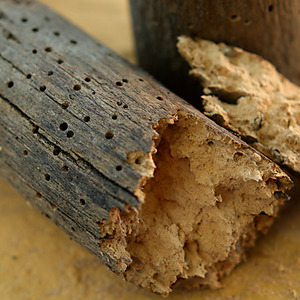In remodeling my kitchen I opened up a wall that now exposes the backside of the bathroom shower/tub. The bathroom wall is 4″ tile over greenboard over 1/2″ plywood. My shower faucet is the old type with 4 handles connected to galvanized supply lines. I would like to get rid of the galvanized and replace the faucet with a new single handle faucet. How can I do this with minimum damage to the tiles? Is there a circular hole boring bit large enough to drill out for the new faucet? For this particular job, is the plywood behind the sheetrock a blessing in disguise? My plan is to remove say 9 tiles and the underlying greenboard, cut a hole for the new faucet in the plywood then replace new greenboard around the hole. Am I on the right track?
Discussion Forum
Discussion Forum
Up Next
Video Shorts
Featured Story

Fine Homebuilding is excited to be the official media partner of the 2024 Building Science Symposium series! This event offers builders, tradesmen, architects, designers and suppliers to discuss topics ranging…
Highlights
"I have learned so much thanks to the searchable articles on the FHB website. I can confidently say that I expect to be a life-long subscriber." - M.K.

















Replies
Rick, as I read your post, the faucet question took a back seat to the greenboard backer. If this gets used much as a shower, that will eventually fail...don't ask me how I know that.
To address your question, unless there is something that's not working about the existing, I'd be inclined to leave it alone.
PJ
Everything will be okay in the end. If it's not okay, it's not the end.
Peter, Thanks for your input. I won't replace the greenboard until it fails and there is no evidence of that now. I usually abide by the principle, if its not broke don't fix it. In this case however, the wall is open and I must replace adjacent galvanized supply lines (ie. line to the bathroom sink) with copper because water was no longer running through it. Is it possible that the galvanized lines to the shower faucet are clogging up but that the brass shower faucet will not develop that same clogging as the galvanized pipes? In which case you would change the lines up to the faucet but leave the existing 4 handle faucet intact?
Are you replacing all galvanized in the house? I think what John Sprung is referring to is galvanic corrosion. If it's piecemeal replacement, be sure to use dielectric couplings between copper and galvanized...or maybe what you have is the result of corrosion?
As long as the valves are working and you can get parts, I guess I don't see the sense in all the work to replace at this point...far easier to do from the shower side when you've getting rid of all that greenboard :) Brass is not corrosion proof, but steel typically has much shorter lifespan.
Another possibility is to use PEX. The galvanized may be supporting the existing fixtures though, which would bend you toward copper, I imagine.
PJ
Everything will be okay in the end. If it's not okay, it's not the end.
Yes, diamond hole saws are available in lots of sizes. Big ones are pricey, though. Given the limited life remaining in the tile work, I'd be inclined to just leave the four old valves in place as historic decoration and a place to hang stuff.
Getting rid of all the galvanized stuff is well worth doing. No matter how nice it may look on the outside, when it's been connected to copper or brass, the inside can still be totally shot.
-- J.S.
John, this kitchen and bath are on the second floor(2 family house). The prior owner had new copper lines run up from the basement. But once the copper got up to the 2nd floor it was connected to the original galvanized going to the kit & bath sinks,shower/tub and toilet. Are you saying that the joining of new copper to old galvanized hastened the corrosion and clogging of the old galvanized?
Do you think that I could get a 7" or 8" hole bit and begin boring in the plywood, going through the greenboard and then through the backside of the tile? Creating a nice clean round hole for the new shower/tub faucet?
> Are you saying that the joining of new copper to old galvanized hastened the corrosion and clogging of the old galvanized?
Yes, that's exactly what happens when you mix them. Dielectric unions may help, but my experience with them hasn't been good.
> Do you think that I could get a 7" or 8" hole bit and begin boring in the plywood, going through the greenboard and then through the backside of the tile?
That can be done. Use a big hole saw to get thru the ply, but stop just a hair short of breaking thru into the greenboard. Cut it out the rest of the way with a utility knife. A diamond hole saw that big will be outasight expensive, I paid $75 for a 1 1/2" one years ago.
A steel toothed saw cuts wood, but gets dulled quickly by abrasive materials like greenboard and tile. The diamond saw cuts tile, but burns up if you push it into wood. Greenboard you can scrape thru with most anything, an expendable utility knife works fine.
The hole doesn't have to be pretty, so the previous suggestion of making a lot of little holes and breaking thru between them will be the cost effective way to it. Start with small holes, then go around drilling them bigger. finish up by breaking out the remaining webs of tile one by one with needle nose pliers.
You might also be able to find a diamond or expendable carbide blade for a recip saw, but the drilling method would be gentler on this weak combination of greenboard and tile.
-- J.S.
Yeah, I have a bit specifically for cutting shower valves in tile.
BTW if you really loved your family, you'd get rid of the green board.:>)
Seriously its really not a good tile backer. One of the things I couldnt stand about my xe business partner. He always went on the cheap.
Providing you have matching replacement tiles,youmay score the groutlines with a utility knife,then drill a series of quarter inch holes with a masonary bit ,then chip out the tiles with a small cold chisel and hammer.Then install the new valve,add cement board and the replacement tiles.Be careful not to drill thru the plywood backer,and make the hole in the backerboard only as big as needed.
Rick,
If the 4" tile is regular wall tile, it has a soft body and can be cut with a jigsaw and carbide grit blade. Or a mini grinder can cut through the tile, then jigsaw the GB and ply to get a neat hole.
Replacing a valve from the back isn't so hard. I preassemble the valve to a block of wood and prefit the copper lines coming off it. Mount the block in the cavity, then sweat the final joints a foot or more from the valve.
Ditto the others on the greenboard. If you are lucky, the tile will fall off it before the plywood all rots away behind the greenboard. Unlucky is when everybody is ill from the black mold and the tile still looks good on the surface. Things are not always what they seem.
Bill
A roto-zip with a circle cutter and a tile bit will be far cheaper than any hole saw that big. Plus you can set the size to whatever you want.
Hey Bryan, I'm sorry, you're a little beyond me. Whats a roto-zip? Are you talking a type of router?
A Roto-Zip is like a larger Dremel tool in a way. I have the Sears Craftsman Version. I bought the kit version. It comes with a plunge router attachment, circle cutter,and an adjustable freehand attach.,for about $100 bucks or so. I've used that baby dozens of times cutting tiles for the round plates that come with most single lever tub and shower valves.It'll cut the curves you need in a jiffy.I clamp a tile in my workmate to make each cut.you can also cut the tiles when they're on the wall. since Igot that tool I find myself using it more & more for all kinds of jobs. VERY versatile. Also if you already have a Dremel or can borrow one it'll do the same.
Generically, they are rotary tools. Many of the big manufacturers make them. Air powered, they are called die grinders. Major power there.Roto-zip has a major brand name in this area, so many people just refer to the tools as roto-zip, even if it isn't that brand.Dremel is a hobby tool, but can work in this instance. I used one to cut a couple of holes for a wall mount faucet in tile. Slow, but it worked. It helped that I had made an outline of the hole with a hole saw. It kept me inside the line.